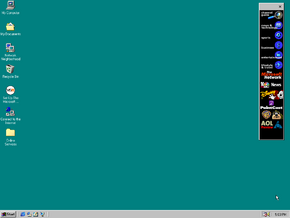Build list legend
Non-existent page
| Version of Microsoft Windows | |
 | |
| OS family | Windows 9x |
|---|---|
| Version | 4.10 |
| Codename | Memphis |
| Architecture | x86 (PC/AT, PC-98) |
| Latest build | 4.10.2222B (98 SE) |
| Release date | 1998-06-25 (original release) 1999-05-05 (Second Edition) |
| Support end | 2006-07-11 |
| Replaces | |
| Windows 95 | |
| Replaced by | |
| Windows Me | |
Windows 98 (codenamed Memphis) is an operating system developed by Microsoft and is the second major release in the Windows 9x operating system line released in 1998. It was designed as an evolution of Windows 95 and introduced features such as the Windows Driver Model, Internet Explorer 4.0 (which included Active Desktop, Windows Desktop Update, and integration with Windows Explorer itself),[1] FAT32 file system (though this was already part of the OEM-only Windows 95 OSR2 two years earlier) and an improved setup process. It is the first version of Windows to include the Windows Desktop Update by default, an addition which carried over to the NT-based Windows 2000 in 1999.
Two versions of Windows 98 were released: the original release in 1998, known simply as "Windows 98" and sometimes retroactively called "First Edition", and "Windows 98 Second Edition" in 1999. The latter fixed major issues from the original release, updated Internet Explorer to version 5.0, included updated drivers and introduced features such as Internet Connection Sharing. Mainstream support for both releases ended on 30 June 2002, and extended support was discontinued later on 11 July 2006—together with Windows Me.
Development on a successor to Windows 95 began shortly after Windows 95's release, with the successor initially being code-named Nashville (with the intended name of Windows 96) and integrating an early version of the Internet Explorer shell integration that would become known as the Windows Desktop Update, based on IE 2.0. However, Nashville was split into two separate projects around January 1996; what would become Windows 95 OSR2 ("Detroit"), and a branch for the next version of Windows, code-named Memphis.
Both Detroit and Memphis were developed in parallel and integrated several features such as DOS 7.10 and FAT32, but development on the Windows Desktop Update slipped into Internet Explorer 3.0, which subsequently split into IE 3.0 - which had some of the shell integration and most of the browsing improvements and was intended to release alongside Detroit, and IE 4.0, which was to bring the full WDU to Memphis. Memphis, which was widely known as "Windows 97" during this time, also included the new Windows Driver Model (WDM), facilitated by a new VxD known as NTKERN which included several Windows NT kernel exports, intended to allow Windows NT and Memphis to use the same drivers. WDM brought with it support for USB and AGP, which later became available downstream on Windows 95 OSR2.1.
Several developer previews were made available for Memphis, which was developed in parallel with Windows NT 5.0 and shared many features with it, including APIs like AlphaBlend. Eventually, Memphis was delayed enough to become Windows 98, which is how it released.
According to Microsoft, Windows 98 requires a 486DX2 66 MHz processor, at least 16 MB of RAM, 175 MB of hard drive space (varies depending on components being installed), and a VGA or better display adapter.[2] The original version of Windows 98 is the last version to be available on 3.5" floppy disks via a mail order, as the Second Edition was only released on CD-ROM discs.
It is possible to bypass most of these requirements via the /nm parameter for SETUP.EXE. By doing so, it becomes possible to install the original release of Windows 98 on an 80386 processor with as low as 4 MB of RAM.
The original release of Windows 98 does not support AMD processors faster than 350 MHz and Intel processors faster than 2.1 GHz due to divide by zero bugs from timer calibration in several drivers.[3] Additionally, Windows 98 (both the original release and Second Edition) does not support having more than 1 GB of RAM due to a bug in the memory allocator.[4][5] Windows 98 will often encounter system instability or crashing upon boot on these systems without additional fixes.
This Easter egg showcases the people who worked on the operating system during development, much in the same fashion as the one in Windows 95. There are two methods of accessing it. The first method involves navigating to WINDOWS\Application Data\Microsoft\Welcome and creating a shortcut for Weldata.exe. At the end of the target textbox in the shortcut properties, add the phrase "You_are_a_real_rascal" without quotes after a space and select the Minimized run option. The second method requires going into the Control Panel and opening Regional Settings, or by going to the map screen in Date/Time Properties in the Time Zone tab. This method is tricker as it requires clicking and dragging three locations on the map while holding down Ctrl the entire time, first by clicking and holding the location of Memphis, Egypt and dragging to Memphis, USA, releasing the mouse button while still holding the key, then clicking again and dragging towards Redmond, USA.
The Easter egg lists 374 team members by name, as well as ten departments (and "many many more...").
Build list legend
This release is known simply as "Windows 98" and also retroactively referred to as the "First Edition".
Second Edition was originally meant to be released as a Service Pack 1 update for First Edition users, as well as a full OEM Service Release, just like Windows 95 OSR 2.x. Early builds were thus made in both forms before SP1 was canceled and OSR1 rebranded as Second Edition that would also be available in retail stores.